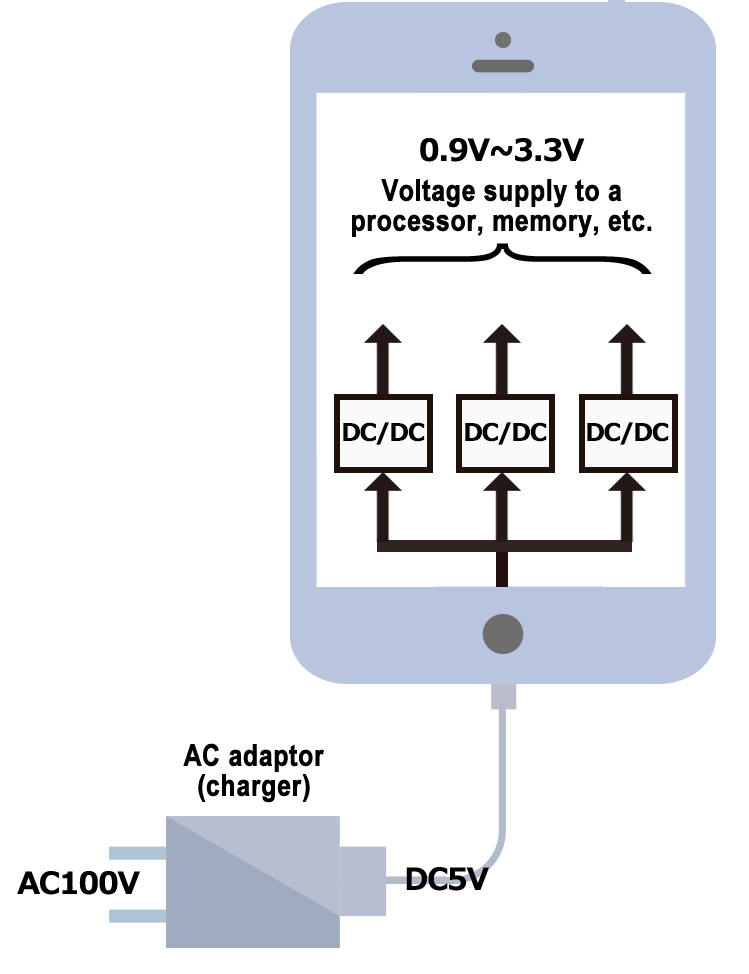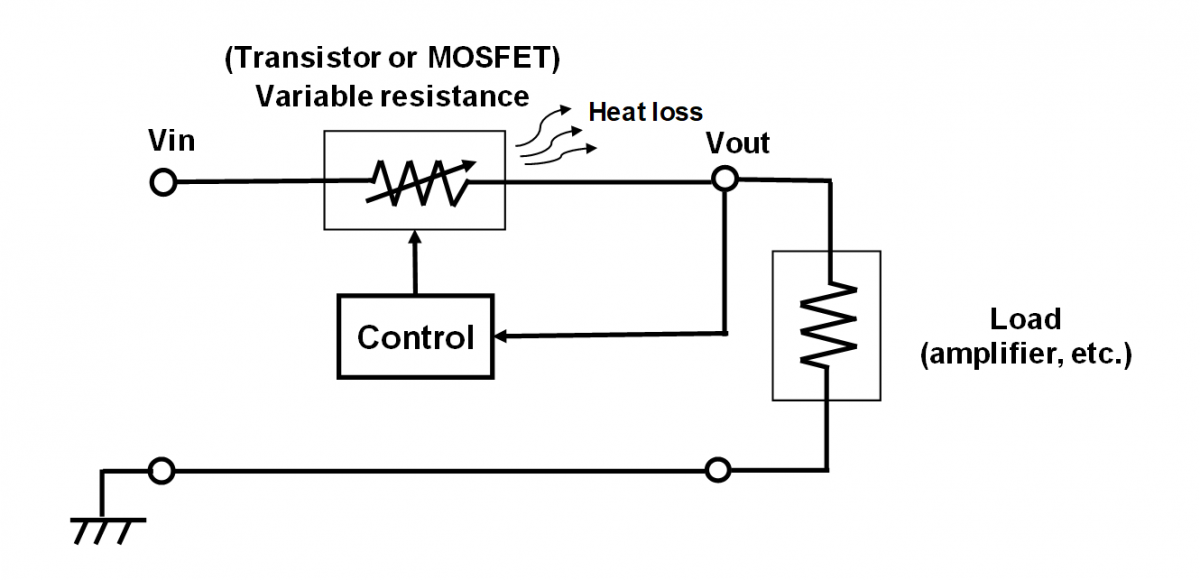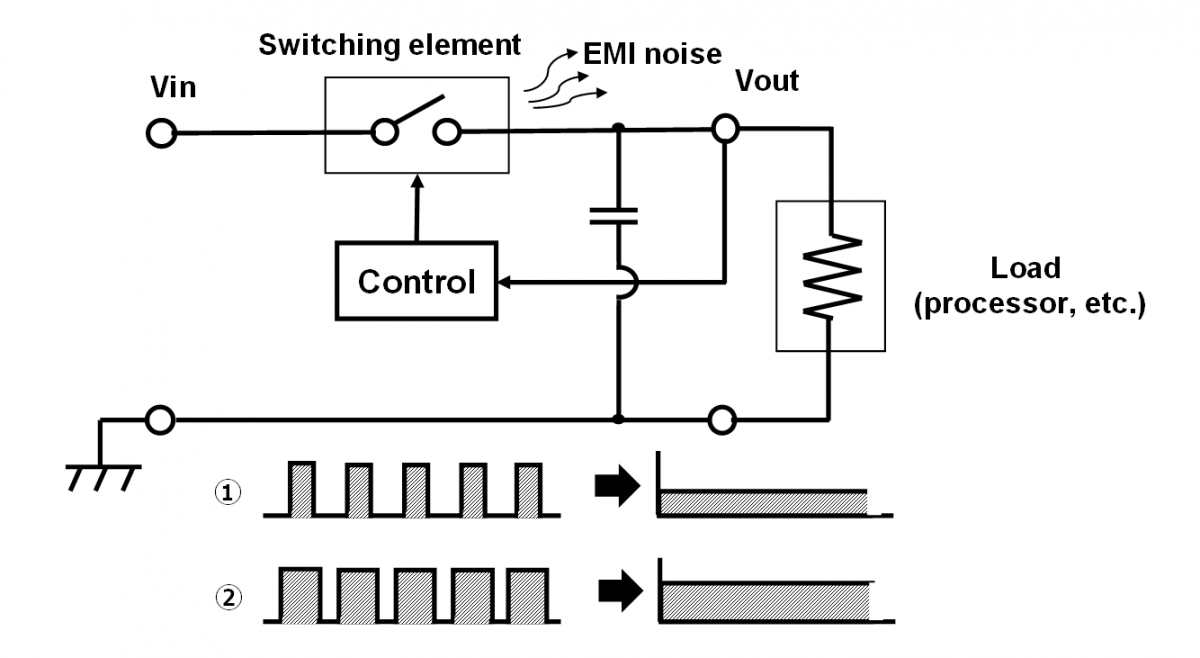Basic knowledge of power supply circuit (1)
-Classification of Power Circuits-
2019-06-17
Power circuits vary in form and operation method, giving rise to various types of power circuits. This basic course mainly discusses DC/DC converters, which are the most common among power circuits and are known as power circuits that convert a DC voltage into another DC voltage. In the first section of this course, we classify power circuits into various types by paying attention to the relationship between input and output.
Function of the power circuit
To ensure the proper operation of electronic circuits and semiconductor devices that make up equipment, we have to supply them with stable voltage and current according to the equipment's specifications. This function is supported by the power circuit. Think of an AC adaptor (charger) for charging your smartphone; it is a kind of power circuit. Obvious to say, a smartphone contains lots of power circuits, which supply the processor, memory, and display with the voltage and current they need (Fig. 1).

Inverters and Converters
From the viewpoint of power output, power circuits are roughly classified into two types of power circuits. Generally, power circuits that output alternating current are called "inverters," while power circuits that output direct current are called "converters."
Inverters
Circuits that convert direct current into single-phase alternating current or three-phase alternating current are called
inverters. A circuit that converts an alternating current with a certain frequency into an alternating current with a
different frequency may also be included in inverters. (Strictly speaking, this circuit first converts an alternating
current with a certain frequency into a direct current and then converts the direct current into an alternating current
with a different frequency. We can say, therefore, that the circuit is composed of a converter and an inverter.)
The field of motor control has the greatest need for inverters. This is because changing the frequency of alternating
current that drives motors to control the motors precisely offers advantages, such as saving energy, which cannot be
achieved by a simpler motor control such as switching on and off. Inverters are incorporated into hybrid cars and
electric cars in which the inverters convert direct current output from large-capacity batteries into a three-phase
alternating current needed for driving main motors.
Converters
A circuit that converts a certain DC voltage into another DC voltage and a circuit that converts alternating current
into direct current are called converters. The former may be written as "DC/DC converter" or "DC-DC converter," and the
latter as "AC/DC converter" or "AC-DC converter." The DC/DC converter is incorporated into many pieces of equipment
including electronic devices and household appliances to supply the microcomputer and memory with the low voltage they
need.
A familiar example of the AC/DC converter is an AC adaptor that is used to charge notebook PCs, smartphones, etc. The
AC/DC converter has a circuit configuration in which a rectifier composed of diodes and a DC/DC converter are combined
together.
Linear Regulator and Switching Regulator
Let us discuss the DC/DC converter, which is the basic form of the power circuit, more specifically. We have mentioned above that power circuits are roughly classified into two types of power circuits, i.e. inverters and converters. Likewise, DC/DC converters are also roughly classified into two types of DC/DC converters - linear regulators and switching regulators.
Linear Regulator
A linear regulator is a power circuit that, based on a principle of voltage division by resistance, divides an input
voltage between a resistance and a load to create an output voltage (Fig. 2). We should note, however, that using an
ordinary resistance in the linear regulator fixes its voltage division ratio, in which case a change in the input
voltage or the load results in a change in the output voltage. For this reason, a transistor or MOSFET is used as a
variable resistance that serves as a voltage divider, and, as the output voltage is monitored, the linear regulator is
controlled to maintain its output voltage constant.
In the linear regulator, because a load current flows through the voltage divider resistance (transistor or MOSFET),
power given as the product of voltage across both ends of the resistance and the load current turns into heat, which is
released as lost power. The linear regulator thus has a disadvantage in that its energy conversion efficiency is lower
than that of a switching regulator, which will be described later on.
The linear regulator, on the other hand, also has a feature where it produces less power output ripples (minute
vibrations like rippling waves) and radiates less electromagnetic noise. Because of this advantage, the linear regulator
is used as a power source for a circuit element that should be protected from noise, such as an amplifier that processes
extremely weak signals. Basically, compared with the switching regulator, the linear regulator can be mounted at a lower
cost.

The variable resistance and the load resistance make up a voltage division circuit where a divided voltage is applied to the load. A current flowing through the voltage divider resistance causes (heat) loss.
Switching Regulator
A switching regulator is a power circuit in which a switching element (power device) switches on/off to turn an input voltage into a pulse wave, which is then smoothed out at an output stage to create an output voltage (Fig. 3). The switching regulator operates according to a basic principle of changing an on/off ratio to control the output voltage.

In this manner, the switching regulator creates the pulse waveform through the switching element that switches on/off and smooths the pulse wave at the output stage, i.e. the rear stage into the output voltage. The switching regulator's operation offers an advantage whereby the output voltage can be controlled through a ratio between an on-time and an off-time. Nevertheless, it also creates a disadvantage whereby the switching action of the switching element generates electromagnetic noise (EMI noise).
There is a high degree of freedom in the design of switching regulators so that various circuit configurations of the switching regulator are devised and put into practical applications. Paying attention to the relationship between the input voltage and the output voltage, we can classify switching regulators into the following three types.
Step-down switching regulator:
This is a power circuit that produces an output voltage lower than an input voltage. It is an ordinary switching
regulator, and is also called a buck switching regulator.
Step-up switching regulator:
This is a power circuit in which an inductor placed on the input side saves energy when the switching element is on and
releases energy when the same is off, thereby creating an output voltage higher than an input voltage. This serves as a
switching regulator for driving devices that require a high voltage, such as an LC panel, LED, etc.
Step-up/step-down switching regulator:
This is a power circuit capable of both step-down and step-up actions. It is used in applications where an input voltage
fluctuates significantly. A basic type of step-up/step-down switching regulator reverses the polarity of power output,
thus outputting a negative voltage. A mechanism that causes the reversal of the polarity is slightly complicated, so we
will discuss this matter in another section. There is a power circuit that is designed to solve the polarity issue and
produce a positive voltage.
The switching regulator has higher energy conversion efficiency than that of the linear regulator. When the latest
controller IC is used as the switching regulator, its energy conversion efficiency reaches about 98% in some cases,
depending on operation conditions. Nevertheless, the switching regulator has a problem arising from its operation
principle; its converting the input voltage into pulse waveforms causes electromagnetic noise (EMI noise) or ground
noise. It also has the disadvantage of complicated circuit design.
| Item | Linear Regulator | Switching Regulator |
|---|---|---|
| Circuits to be driven | Amplifier circuits, high-frequency circuits, small current circuits, cost-cut-oriented circuits, etc. | Processors, memories, graphic chips, network controllers, LCs, organic ELs, etc. |
| Voltage conversion | Step-down only | Step-down, step-up, step-up/step-down (polarity reversal, no polarity reversal) |
| Output current | About several hundreds of mA to 1A in many cases | It can be configured as a circuit capable of outputting a current of 100 A or larger, depending on an external power device attached thereto. |
| Energy efficiency | Energy efficiency drops when there is a significant difference between the input voltage and the output voltage. | Approximately 80% to 90% (98% at maximum) |
| Noise | Hardly generates. | Inevitably generates due to its operation principle. |
| Design-related difficulty (technical difficulty) | Low | Relatively high (in the case of a single chip module, etc.) |
| Cost | Low | High |
In the next section, we will discuss the switching regulator, which is indispensable to electronic circuits.
Summary

- A circuit that outputs alternating current is called an "inverter," while a circuit that outputs direct current is called a "converter."
- A converter with a commonly used circuit configuration is referred to as a "switching regulator."
- Switching regulators include step-down switching regulators, step-up switching regulators, and step-up/step-down switching regulators.
- The switching regulator has the advantage of high energy conversion efficiency, but it also has the problem of generating electromagnetic noise.


